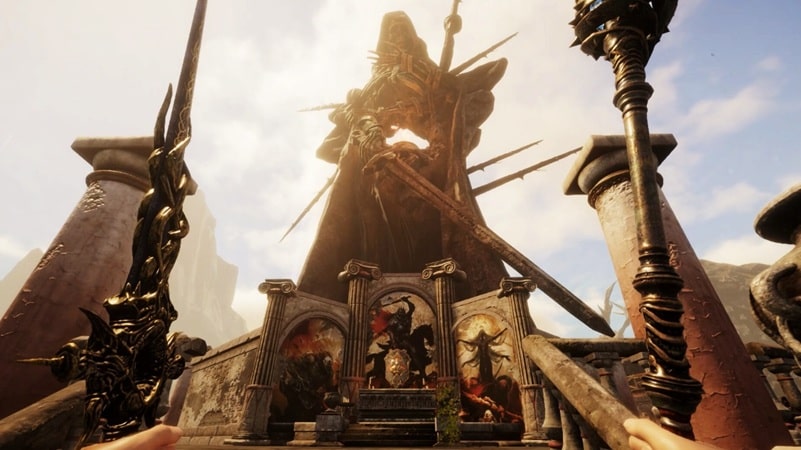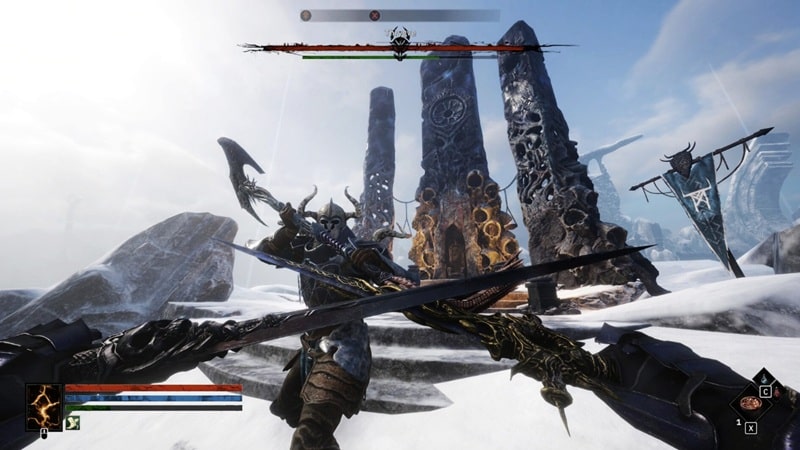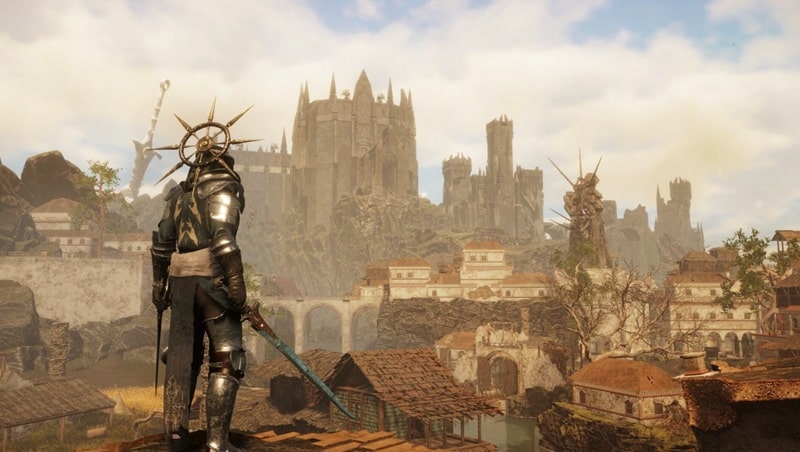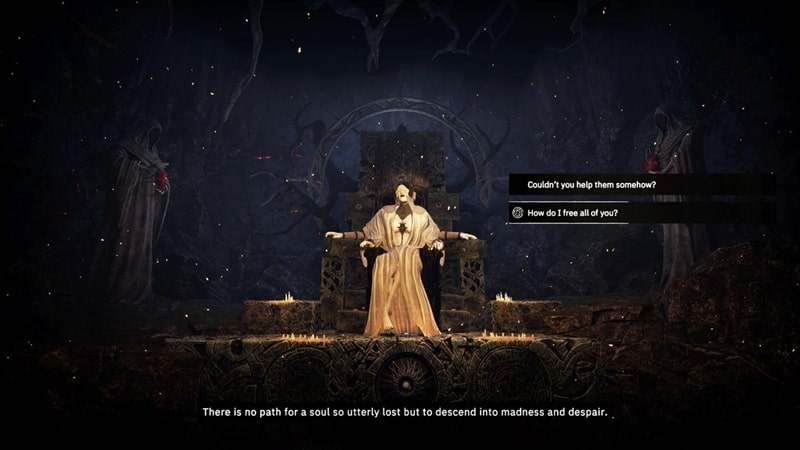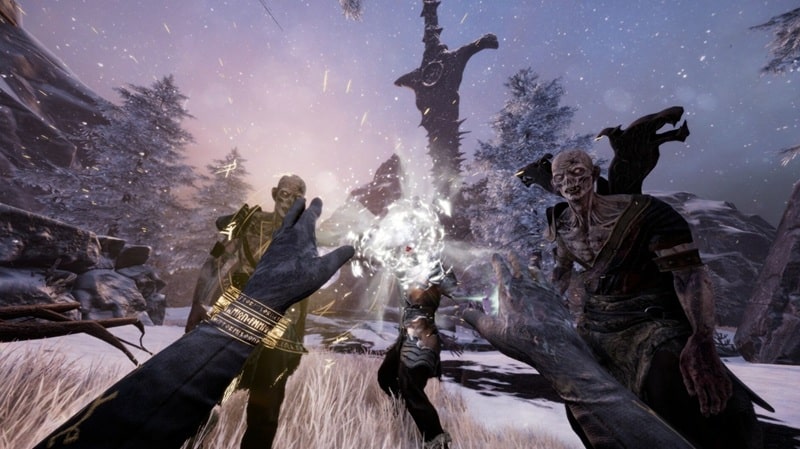Even though The Elder Scrolls V: Skyrim is seemingly set to join fellow Bethesda property DOOM in being re-released more times than John Cena has had world titles, there’s still very much an appetite even among those more disillusioned Elder Scrolls fans for something similar to Bethesda’s legendary RPG epic. Especially as The Elder Scrolls VI feels more and more like a whispered curse, then a tangible game that we’ll ever get to play in our lifetimes. Enter then Tainted Grail: The Fall of Avalon from Polish studio Questline which reframes the Skyrim style, open-world RPG epic with a darkly fantastic take on the Arthurian legend quite unlike any other.
In the opening thirty minutes of Tainted Grail: The Fall of Avalon, it’s certainly difficult not to draw reactionary parallels with another Bethesda RPG epic – The Elder Scrolls IV: Oblivion (freshly inserted into the discourse thanks to its recently released Unreal Engine 5 remaster). Indeed, after you have created your character, chosen your class and named your protagonist, you find yourself thrown into a dingy dungeon and it isn’t long before a mysterious figure rocks up and grants you your freedom, and, well it’s very much off to the races from here on.
Tainted Grail: The Fall Of Avalon PS5 Review
The Indie Skyrim That Could
And to be very clear, Tainted Grail: The Fall of Avalon has absolutely been designed, at least as far as its fundamentals are concerned anyway, against the same blueprint that Bethesda has used for its Elder Scrolls series of titles. For the uninitiated then (all two of you), what this essentially means is that the action predominantly unfolds from a first-person perspective – there is a third-person option, but it’s a bit crap so don’t bother – and has you wandering around the world hacking/spelling enemies to death, speaking to NPCs, picking locks (complete with a very familiar lockpicking minigame) and generally doing a whole bunch of stuff that you might catch yourself doing in Skyrim.
In addition, there are also multiple class types with different skill trees and stats which, depending on what you invest your points into, allows you additional options in conversations that you wouldn’t normally have. All of this is fine, but where Tainted Grail: The Fall of Avalon seeks to put some distance between itself and Bethesda’s long-running RPG juggernaut is in its setting, writing and embrace of a wonderfully non-linear narrative.
To give a quick bit of exposition in regard to the story, Tainted Grail: The Fall of Avalon puts a unique spin on the Arthurian legends. Set some 600 years after the fall of King Arthur, Tainted Grail: The Fall of Avalon thrusts players into a world mangled, crippled and twisted by King Arthur’s grim legacy. Unfolding on the mist-shrouded isle of Avalon, it quickly becomes apparent that a mysterious and seemingly malevolent primal force known as the Wyrdness has taken hold, warping the flora and fauna that it comes into contact with and destroying the minds of those who willingly embrace it’s forbidden power.
Further Reading – Upcoming PS5 Games 2025 – The Best PS5 Games Coming Soon
It’s against this background of a fantastical, autumnal world in decline that Tainted Grail: The Fall of Avalon unfurls its narrative tapestry and honestly, it’s super compelling stuff that simultaneously feels fresher than anything Bethesda has come up with in its Elder Scrolls games, while also breathing new life into those Arthurian legends of old. Without wanting to veer too deeply into spoiler territory, Tainted Grail does something really quite interesting with its Arthurian story beats, setting up a surprisingly effective moral dilemma that sits at the heart of its narrative setup, neatly underscoring its commitment to non-linear storytelling in the process, but more on that in a bit.
Much more than fancy lore window dressing, the setting that developer Questline has employed here is threaded through every strand of Tainted Grail’s visual design DNA, lending it a look and feel that feels really quite separate from comparable genre offerings. From towering bound crimson titans to half-submerged statues, shimmering pools of blood and grand crumbling castles, Tainted Grail certainly makes the most of its gothic Arthurian stylings. Despite largely taking place on a single island, there’s also a remarkable variety of environment types on offer too, with Tainted Grail whisking players off to all manner of creepy crypts, abandoned coastal settlements, snow-dappled mountains, golden leaved forests and so much more besides. Put simply, there’s a deeply impressive amount of variety and style on offer here from a developer that had a fraction of the budget when compared to its contemporaries.
Much more than skin deep, Tainted Grail’s natty setting is woven into the world on a functional level, too. You see the Wyrdness, that mysteriously potent primal force of power, manifests itself within Tainted Grail’s world in ways that are both aesthetic and impactful to the moment to moment gameplay. You see, the Wyrdness becomes stronger at night time and is able to manifest itself in the physical realm by not only coating the environment with an eerie golden shimmer and thickening the fog that shrouds the land (and making your viewing distance shrink greatly as a result), but also by conjuring spectral ‘Wyrdlings’ that will swarm and attack you on sight. As a result then, the presence of the Wyrdness makes you think much more tactically than you normally would, encouraging you to do your exploring and questing during the day and shut yourself in somewhere nice and protected at night (if you can). More of this kind of thing please RPG devs.
Another key area where Tainted Grail does really rather well for itself is in the realms of writing and quest design with the two neatly dovetailing into one another throughout. The many different thousands of conversations and embedded dialogue trees that you’ll see in Tainted Grail across its many NPCs all feel quite refreshing, this is thanks in no small part to how dryly sarcastic your character can be. Sure, sarcasm much like sass can be overused as a dialogue device, but here it’s used just enough and with enough wit that it never feels overbearing.
Developer Questline deftly extends the heady quality of its writing directly into Tainted Grail’s compelling non-linear quest design, too. In one such early example, the player is tasked by a local captain to remove a necromancer that has been disturbing the undead in a nearby graveyard. However, when you finally confront this seemingly terrifying raiser of the dead, it soon transpired that he actually has an unexpectedly benevolent reason for his resurrection of the dead. Essentially our black robed boy wants to understand what death is like and how he can use it to make the undead more easily controllable and less prone to feral savagery.
The thing is, while you can just rock up to his crypt and kill him, there are a range of other outcomes too. Indeed, there’s even one outcome where you can convince him that the best way to understand the undead is to become one of them himself, which ends up being rather amusing to say the least. And really, the quality of the dialogue (and this also includes some surprisingly decent voice acting) also lends itself well to reinforcing the world building that Tainted Grail more or less successfully pulls off. Sure, Avalon doesn’t quite have the storied history of Cyrodil or Skyrim which was established across a number of games and across a number of decades at this point, but Questline has nonetheless done a good job of lending Avalon a real sense of heft to its lore which in turn makes exploration of its sprawling lands something you’ll want to do.
Where Tainted Grail comes a little unstuck is on the technical side of things, which perhaps speaks more to the studio’s modest size and production budget than anything else. From a visual perspective, Tainted Grail looks less like a current generation title and much more like an earlier last gen offering. Though the visual style is strong and the world itself is striking thanks to its gothic tone, the geometrically basic environments coupled with some low detail texture work and simplistic character models fail to impress, not to mention a variable frame rate and the expected heaps of jank being the figurative cherries on an uninspiring technical cake.
Beyond such technical issues, Tainted Grail also has a number of Quality of Life issues that can aggravate. In one such example, when you use a spade to dig or a pickaxe to mine ore, it doesn’t automatically snap back to your main weapon loadout – which can be troublesome if you’re immediately under attack after the fact. Again, none of these kinds of issues are deal breakers, but taken in tandem it can again make Tainted Grail feel a little less polished than its immediate peers.
A welcome surprise, Tainted Grail: The Fall of Avalon really clicked with me. The Euro indie Skyrim that could, Tainted Grail: The Fall of Avalon might not be as technically sound as other genre efforts, but across its 60-80 hour playtime there’s a lot to enjoy here, while its inventive take on Arthurian legends and surprisingly effective writing all add up to make it a compelling prospect for RPG fans everywhere that don’t want to wait 89 years for the next mainline Elder Scrolls title to drop.
Tainted Grail: The Fall of Avalon is out now on PS5.
PS5 code and physical edition kindly provided by PR.
